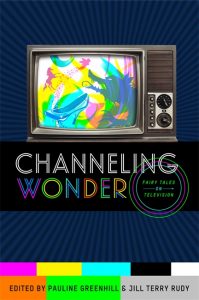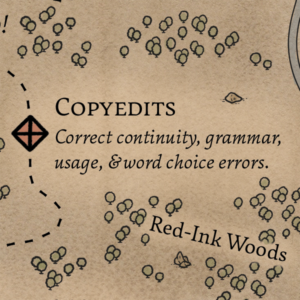 The Red-Ink Woods of copyediting are the last place your book goes as a manuscript in your book journey. After copyediting, it gets reskinned for page proofs/galleys, then on to publishing! [Read more…] about The Red-Ink Woods
The Red-Ink Woods of copyediting are the last place your book goes as a manuscript in your book journey. After copyediting, it gets reskinned for page proofs/galleys, then on to publishing! [Read more…] about The Red-Ink Woods
copyediting
Split Your Book Journey Party
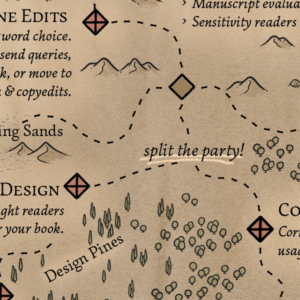 If you picked the self-publishing fork in the road after the Line Edit Foothills, it’s time to split your book journey party. You’ve got multiple quest objectives, and you can accomplish some of them at the same time if you plan it right. Right now you need to do two things: polish your manuscript and put together the graphic design pieces that make your book visually delightful. [Read more…] about Split Your Book Journey Party
If you picked the self-publishing fork in the road after the Line Edit Foothills, it’s time to split your book journey party. You’ve got multiple quest objectives, and you can accomplish some of them at the same time if you plan it right. Right now you need to do two things: polish your manuscript and put together the graphic design pieces that make your book visually delightful. [Read more…] about Split Your Book Journey Party
New: Comic Book Ebook Design for Kindle
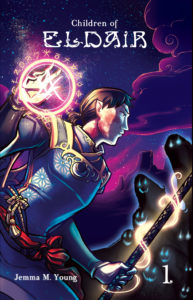 Looseleaf now offers comic book ebook design for Kindle! The first two projects we’ve helped produce are Book 1 and Book 2 of Children of Eldair, a full-color portal fantasy comic by Jemma M. Young. (Looseleaf also copyedited and proofread Book 2.) You can buy both the ebooks and the gorgeously printed paperbacks on Amazon (Book 1 is available now; Book 2 is forthcoming), and when you’ve finished those off, you can see the latest pages on a regular basis at Eldair.com.
Looseleaf now offers comic book ebook design for Kindle! The first two projects we’ve helped produce are Book 1 and Book 2 of Children of Eldair, a full-color portal fantasy comic by Jemma M. Young. (Looseleaf also copyedited and proofread Book 2.) You can buy both the ebooks and the gorgeously printed paperbacks on Amazon (Book 1 is available now; Book 2 is forthcoming), and when you’ve finished those off, you can see the latest pages on a regular basis at Eldair.com.
File Formats for Comic Book Ebook Design
Ebooks aren’t usually the first option for comics. Most ebooks are reflowable, which means the text can shift around to let readers adjust the size and other aspects to suit their reading choices. Comics, with their rich, dense illustration and specifically placed text, don’t do well in a reflowable book. But if you want to publish a portable, electronic version of your ebook, don’t settle for a static PDF. The Kindle format is your best bet. Amazon has created a platform that readily integrates panel magnification in a way that keeps file sizes low while making it easy for readers to zoom in on intricate artwork, dialogue text, and more. EPUB format (which Nooks, iBooks, Kobo devices, and more use) can do similar things, but the code is more complex, and the files can become large, especially with detailed or lush artwork (like Jemma’s work with Children of Eldair). EPUB files need to be compatible with many different platforms and devices, while Kindle files wrangle only with different devices.
But even with a ready-to-run format, the time spent building an ebook is time you aren’t writing, drawing, inking, lettering, and/or coloring your comic. If you want a Kindle-ready version of your comic, trust Looseleaf with your story. We’ll get it reader ready. Need more information? Get a quote on your comic book ebook design.
Not a comic book writer? We’ve got you covered with standard print and ebook design pricing.
Recent Fairy-tale Projects
Since I last posted, I completed my master’s degree in English, moved house, worked on dozens of projects, and got a dog and six chickens. But today I’d like to highlight three recent-ish projects that are on the same topic: fairy tales.
The first project, Channeling Wonder: Fairy Tales on Television, is a collection of scholarly essays edited by Pauline Greenhill and Jill Rudy and published by Wayne State University Press. I indexed the volume, and it was a pleasure to read (not to mention the fact that it fed into research for my master’s thesis). The topics contained in the book are broad, and the various authors bring unique concerns, interests, and perspectives to the discussion about fairy tales on television. And look at that cover! Isn’t it nice to find an academic press that takes a little pride in the designs as well as the content?
The book spawned another project I worked on: Fairy Tales on Television. I was one of many research assistants and contributors who made the searchable database and functional data visualizations possible. The database is a research tool for researchers and creators whose interests intersect with fairy tales and television. I’ve used it for research of my own, and I might be preparing an infographic summarizing my findings. (So stay tuned for that.)
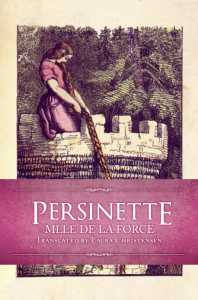 Outside of academia, I also had the opportunity to work with Laura Christensen, a French-to-English translator who translated “Persinette,” a literary French fairy tale similar to “Rapunzel.” Laura translated the tale, wrote a delightful introduction, provided some biographical information on the author, and included introductions to and public-domain translations of the Grimms’ “Rapunzel” (which was published after “Persinette”) and Giambatista Basile’s “Petrosinella” (an Italian tale published before “Persinette”). I copyedited the text (except the public-domain translations) and formatted everything for its upcoming ebook release. Laura lets you know where you can find her collection on her translation website.
Outside of academia, I also had the opportunity to work with Laura Christensen, a French-to-English translator who translated “Persinette,” a literary French fairy tale similar to “Rapunzel.” Laura translated the tale, wrote a delightful introduction, provided some biographical information on the author, and included introductions to and public-domain translations of the Grimms’ “Rapunzel” (which was published after “Persinette”) and Giambatista Basile’s “Petrosinella” (an Italian tale published before “Persinette”). I copyedited the text (except the public-domain translations) and formatted everything for its upcoming ebook release. Laura lets you know where you can find her collection on her translation website.
The Dash Family and Saying What You Mean
There are some people who don’t bother much with punctuation or think that quibbles about commas are purely subjective. In some instances I’d agree with them, but overall, punctuation exists to help you say what you mean. Punctuation helps you emphasize what you want emphasized and communicate nuances of meaning you would add if you were speaking to your reader in person.
That’s why I find the differences between the three members of the Hyphen-Dash family absolutely critical. Just like any other family, the members share some traits, but have their own distinct qualities. Those qualities help you say way you mean when you write. I can’t cover all the nuances of the Hyphen-Dash family here, but I can give you a crash course.
Meet Hyphen
Little Hyphen is the smallest member of the Hyphen-Dash clan. He looks like this: -. For contrast, here’s en dash (–) and em dash (—). He’s so common that you can use him to verb something. And yet Lynne Truss, the delightful author of my favorite punctuation book, Eats, Shoots and Leaves, calls Hyphen “a little used punctuation mark” in her chapter about him. That’s because Hyphen is confusing, and he’s an utter pain to use correctly.
Figuring out when to hyphenate a noun is relatively easy. If you want to know if you should say butter fly, butter-fly, or butterfly, you go to Merriam-Webster, type in any of the options, and see which one pops up. Simple. (Unless we’re talking about something like e-mail versus email, in which case it gets more complicated.)
Hyphenating adjectives trips more people up. I’m going to focus on the trickiest instances. The important thing to remember is that Hyphen exists to clear up ambiguities. Thus, to use Truss’s examples, you hyphenate shell-like because having three Ls in a row is a mess, and you hyphenate de-ice because deice could very easily be a word that meant something other than getting ice to go away.
Hyphenated adjectives work the same way. When you hyphenate two words, you essentially turn them into one word. For example, the phrase ugly bug juice could mean juice from ugly bugs or bug juice that is ugly. If you sprinkle in some of Hyphen’s charm, he can solve that ambiguity: ugly-bug juice is juice from unfortunate-looking bugs and ugly bug-juice is bug juice that happens to be unpleasant to see. So if you have two adjectives in front of a noun, determine whether you’ve laid an ambiguity trap. If you have, use Hyphen to build a bridge over it.
Meet Em Dash
Papa Em Dash is probably the punctuation mark most people get right—fact of the matter is that he’s hard to use wrong. Em Dash stands for an abrupt change in thought, in place of parentheses, in place of omitted letters in a name, for a cut-off statement, and sometimes even in place of quotation marks (though I don’t recommend it).
The problem is that Em Dash is so big (the width of an M in whatever font you’re using) that he draws a lot of attention to himself. So it’s best to limit your use of him. Use him when you need an interruption in your sentence—be that for pacing purposes or for a change in topic—and for very little else. If you use him sparingly, he’ll be more effective.
To get a true en dash in MS Word on a PC, hit CTRL + ALT + the minus key on your keyboard’s number pad (the hyphen key next to the zero is not the same). If you’re writing online, the HTML code for Em Dash is —. Stick the ampersand, mdash, and the semi-colon in your HTML code and you’re good to go.
Meet En Dash
En Dash is probably the least-known and least-understood member of the Hyphen-Dash family. But she can really communicate a lot for a line that is only the width of an N.
According to the Chicago Manual of Style (I call it BOB, for Bright Orange Bible, even if they did put a blue dust jacket on the latest edition), En Dash can stand in for to, signify an unfinished number range, assist with compound adjectives, and a few other assorted uses. It’s easiest to understand this through examples.
Standing for to. 2003–2010 means the years from 2003 TO 2010, whereas 2003-2010 could mean the same thing (incorrectly), or it could mean a file number that includes the numbers 2,003 and 2,010. This use can also appear outside of numbers. You can have a Cardiff–London train, for example, and author–editor interaction (which involves an author and an editor, whereas author-editor interaction is the interaction of one individual, an author-editor).
An unfinished range. 1993– would probably mean the life span of someone who hasn’t died yet. Hyphen is too small to really stand for a continuing life; instead it would seem like he was misplaced on accident. En Dash looks a lot more intentional.
In compound adjectives. Using En Dash with complicated adjectives is the most fun, and it’s also where she’s most important. En Dash connects adjectives made up of multi-word phrases or words that are already hyphenated. Observe: post-World War II years compared to post–World War II years (the first means years after War #2 after the end of the world, the second means after the second World War).
To use an en dash, in MS Word on a PC hit CTRL + the minus sign on your keypad. In HTML, use –.
The Takeaway
If you’re someone who has moaned about the limitations of the written word, but you haven’t taken a closer look at the punctuation options you have, stop moaning and start studying. There could be all sorts of nuances you’re missing out on.
Honest Editorial Feedback without Gatekeepers
 The rise of electronic self-publishing has led many authors to circumvent the traditional “gatekeepers” of the publishing world. In some instances that means a wonderful book with a niche audience or a cross-genre appeal finds its way to an audience even though a large press can’t afford to take a risk on it. Sometimes a great author gets more control over his or her process. Other times it means something awful joins the abundance of books already on the market because the author used self-publishing as a last resort.
The rise of electronic self-publishing has led many authors to circumvent the traditional “gatekeepers” of the publishing world. In some instances that means a wonderful book with a niche audience or a cross-genre appeal finds its way to an audience even though a large press can’t afford to take a risk on it. Sometimes a great author gets more control over his or her process. Other times it means something awful joins the abundance of books already on the market because the author used self-publishing as a last resort.
Edan Lepucki, a literary fiction writer, recently talked about the issue of last-resort publishing when she wrote an article entitled “Reasons Not to Self-Publish in 2011-2012: A List.” Her reason #5 was “I Value the Publishing Community.” She talks about how she values editorial input and the layers that get added to a novel when an editor works on it. She says:
I know you can hire experienced editors and copy-editors, but how is that role affected when the person paying is the writer himself? What if the hired editor told you not to publish? Would that even happen?
As far as Looseleaf is concerned, the answer to whether or not that would happen is sometimes. It depends on what I’ve been hired to do. If I’ve been hired to copyedit, then I will copyedit. The publishability of the manuscript is not the problem I’ve been hired to solve: I’ve been hired to address its coherency on a grammatical and syntactic level. I will do what I’ve been hired to do. Likewise, the copyeditors at your favorite publishing house probably don’t control what goes to press, just the grammatical state in which it goes to press.
Copyediting is not the only thing you can hire an editor to do, though. Looseleaf offers manuscript evaluations (as do many other editing companies), which are essentially an in-depth way of answering the publishability question. In an evaluation I look at plot, character, and overall coherency, which also means I put myself in the reader’s shoes and analyze whether or not the book in my hands adds anything to the market. In the editorial letter I send to the author afterwards, I include positives, negatives, and an overall judgement on the manuscript.
Lepucki asks how the editorial relationship is affected when the editor is an employee of the author. The truth is that the freelancer–author relationship is not the same as the in-house editor–author relationship. A freelancer does what he or she is hired to do. If you want honest editorial feedback, hire a freelancer to give it to you and you’ll get it.
But Lepucki asks a question I can’t answer: “What if the hired editor told you not to publish?” That is a question for the author, a question that applies to all self-publishing authors. If you’ve decided to publish something on your own and hire someone to offer his or her opinion on your decision, are you going to listen if you get told you’re wrong?
Image by Rawich via FreeDigitalPhotos.net
Looseleaf Copyediting
This week I’m going to look at each of Looseleaf’s editorial services and tell you what they are, when you need them, and some tricks you can use to do some editing yourself before you hire it out. Today is copyediting day.
 What Is Copyediting?
What Is Copyediting?
Copyediting is a nuts-and-bolts type of editing that focuses on grammar, spelling, punctuation, style, and consistency. When I copyedit I polish your work. I make sure your character’s eyes stay the same color throughout the book and that you capitalize words or phrases the same way from beginning to end; I make sure you get the I’s before the E’s (except when you shouldn’t) and that your pronouns agree in number and gender with whatever they’re standing in for. Copyediting is, essentially, what most people think of when they think of editing. It’s cleanup.
Sometimes copyediting isn’t necessarily a right-or-wrong type of thing.* There are a lot of language scenarios in which you have more than one option. For example, you might be using whom in a grammatically correct way and un-dangling your prepositions (“Willis needed to figure out to whom he should send the package”), but that might not suit your character voice or the tone of your book (and maybe “Willis needed to figure out who to send the package to” would be better). When I’m copyediting, it’s my job to make sure you stay consistent in your language choices and that they align with the message you’re trying to portray. (If you’re writing something scholarly, that means I’ll scour your citations and make sure they’re correct down to the spacing between the periods, because it’s important to your credibility.)
Copyediting goes a long way to increase your credibility, and nothing will hobble your street cred faster than a misspelled word, misplaced modifier, or missing quotation mark. Copyediting gives your work polish.
When Does a Manuscript Need Copyediting?
A manuscript needs copyediting after the content of the manuscript is completely satisfactory. (If you copyedit before your final revision, the copyediting becomes a little superfluous because your final changes are going to effect your wording, which means you’ll need to do the copyediting again.) When you’re sure your story, study, or article says everything you want it to say in the way you want to say it, you need copyediting to make sure all your words, phrases, and facts flow. Copyediting comes after you’ve deemed your work “done” and you’re ready for final touches.
How Can You Do Some Copyediting Yourself?
Copyediting is a hard thing to do for yourself, mostly because by the time you’re copyediting you’ve seen your manuscript too many times to count. It’s also hard because you know what you meant to say, so you might not be able to see that you didn’t actually say what you meant to. However, there are a few things you can do to help yourself.
- Change the form of your manuscript before you edit it (print it out, put it in a different font, etc.) The more you can defamiliarize yourself with the text, the better you’ll be able to edit it.
- Use electronic tools to search for a phrase and make sure it appears the same way throughout your manuscript.
- Keep a sharp eye out for errors you know you’re prone to.
- Be wary of homophones (words that sound like each other but mean different things): your / you’re, their / they’re / there, lead (metal) / led (past-tense of to lead), etc.
- Read your manuscript backwards. This helps you see when you’re missing words in common phrases that you might not see otherwise.
- Read your manuscript out loud.
- Look things up. Use a solid online dictionary (like Merriam-Webster) or other resource. It also wouldn’t hurt to have a reference book or two on hand if you know how to use them (i.e., a usage dictionary or a style guide like the Chicago Manual of Style).
Overall, I don’t recommend doing your copyediting yourself, though it may be a good idea to have a friend or two look over the manuscript before you hire a copyeditor. The further someone is from your manuscript, the better they’ll be at catching little mistakes.
Other Editorial Services
________________________
* As an example, copyeditors don’t even agree on what to call themselves. Sometimes they’re copy editors instead of copyeditors.
Image by scottchan via FreeDigitalPhotos.net
Before You Hire an Editor, Know What You Need
Before you hire a freelance editor, you need to decide what type of editing you want right now. It’s also good to know what types of editing you’re going to want in the future; sometimes you can work with the same editor through the whole project, or you can at least work with people your editor refers you to.
You need to know what type of editing you need because editors are not wizards. You can’t take a book you think isn’t quite there, hand it off to an editor, and get it magicked into complete perfection. Editors can help you improve your writing and hone your craft, but they can’t force absolute quality on you (even if they could, it wouldn’t really be your book afterward). The clearer you can be about the type of help you want, the better an editor can help you. An editor cannot effectively edit everything from commas to character arcs all in one go. That takes multiple passes over a manuscript, and you, the author, should be revising after each pass to make sure the piece stays true to what you want it to be.
Writing a story or nonfiction piece means creating a path from beginning to end, and ideally that path will have scenic vistas along the way. Editing involves trying to make that path clear and enjoyable for your reader. If you take the path-making metaphor a bit farther, you’ll understand why you can’t have someone do story-level developmental editing and sentence-level copyediting at the same time. You don’t hire a lumberjack to pull weeds; you don’t hire a golf-course manicurist to move massive boulders. Understand the task you want to hire out so you can hire the right person.
Developmental Editing (Story Editing)
Developmental editing is large-scale editing. In this type of editing the editor makes sure there are no redwoods blocking the path you’re trying to create for the reader. It also includes pointing out any opportunities you may have missed. Perhaps you could have pulled more tension out of a character’s relationship; maybe you ignored an argument your opponents will make; then again, maybe you just have a big plot hole or lapse in logic. A developmental edit involves multiple editorial passes and a lot of editor–author interaction to hone and develop your plot or argument, tone, characterization, and more. This is the lumberjack-and-boulder-removal level of editing. If a developmental editor also tried to do copyediting along the way, he or she could easily miss some uncharacteristic dialogue because he or she was more focused on the punctuation of a nonrestrictive clause.
Learn more about developmental editing from this Looseleaf blog post. Another editing service that is related to developmental editing is the manuscript evaluation or critique.
Substantive Editing (Line Editing)
Substantive editing goes into more fine-tuning than moving boulders: it’s more like clearing the path of hedges and shrubbery and making sure it’s as direct as possible. Substantive edits cover organization, logical flow, word choice, internal consistency, and more. It can go as big as reordering paragraphs and as fine as tweaking a word to sustain your tone. Often a substantive edit can include a lot of copyediting because it is more sentence- and word-based than developmental editing. However, it should not be confused with a true copyedit. Substantive editing involves a lot of tweaking, reordering, and decision-making from the author. By the time the edit is done you’ll have changed a lot of text, and any time you make lots of changes you need to go back and make sure the details of those changes are clear.
Learn more about substantive editing from this Looseleaf blog post.
Copyediting
Copyediting looks at the potholes and pebbles along a manuscript’s path. The editor shifts word and punctuation debris so readers won’t twist their ankles while enjoying your story. Everything gets edited for grammar, spelling, punctuation, style, consistency, and adherence to your chosen citation format (this could be everything from the color of your characters’ eyes to how you capitalize certain words and phrases). Sometimes copyediting isn’t necessarily a right-or-wrong type of thing. There are some language scenarios in which you’ll have more that one option. It’s a copyeditor’s job to make sure you remain consistent in which option you choose.
Learn more about copyediting from this Looseleaf blog post.
Proofreading
Proofreading is a lot like copyediting in that it’s concerned with potholes and pebbles. However, a proofread is performed on the final version of a publication. It should always be done by someone who hasn’t previously edited your work (Looseleaf uses some trusted subcontractors to do the proofreading on projects I’ve already edited). The proofreader catches last-minute errors and items that you, the author, would change yourself if you had your attention drawn to them. Proofreaders also catch formatting errors like over-spaced lines, misplaced hyphens, widows and orphans, word stacks, and inconsistent typeface use. Anything that will disrupt the reader’s final experience gets caught during proofreading.
Learn more about proofreading from this Looseleaf blog post.
An Editorial Relationship
If you want a long-term working relationship with a particular editor, make sure you can get all the types of editing you’re going to need from that editor or from professional acquaintances of that editor. By working with one individual or a collection of close contacts, you’ll be better able to retain your vision and voice across the different stages of editing. For example, when I hire out final proofreading on projects I’ve edited, I review the proofreader’s changes to make sure they don’t go back on anything the author and I have previously talked about. This helps retain the author’s intentions and goals for the project.
Before you hire, know what you want. You’ll be happier with your final product and you’ll save a lot of negotiation with your editor if you can articulate what it is you want him or her to do.
Image by Rob Wiltshire via FreeDigitalPhotos.net
